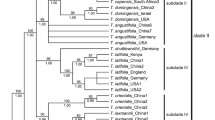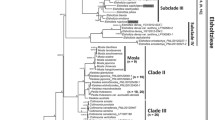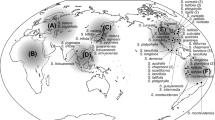Abstract
Sassafras (Lauraceae) consists of three species disjunct between eastern Asia (S. tzumu and S. randaiense) and eastern North America (S. albidum). Phylogenetic analysis based on sequences of nuclear ribosomal ITS and three chloroplast non-coding regions (rpl16, trnL-F, and psbA-trnH) showed that Sassafras is monophyletic and that the eastern North American S. albidum is sister to the clade of its two eastern Asian counterparts. Their intercontinental divergence was estimated to be 13.80 ± 2.29−16.69 ± 2.52 million years ago (mya) using the penalized likelihood method with the ITS and three chloroplast markers. Biogeographic analyses combined with fossil evidence suggest that Sassafras has a relict distribution in the Northern Hemisphere without a Gondwanan link. The divergence time of the two eastern Asian species (the continental Chinese Sassafras tzumu and S. randaiense endemic to Taiwan) is estimated to be 0.61 ± 0.75−2.23 ± 0.76 mya. Sassafras randaiense from Taiwan was most likely derived from an ancestor from continental China.
Similar content being viewed by others
References
Baldwin B. G. and Sanderson M. J. (1998). Age and rate of diversification of the Hawaiian silversword alliance (Compositae). Proc. Natl. Acad. Sci. USA 95: 9402–9406
Blake S. F. (1918). Note on the proper name for the Sassafras. Rhodora 20: 98–99
Chanderbali A. S., van der Werff H. and Renner S. S. (2001). Phylogeny and historical biogeography of Lauraceae: evidence from the chloroplast and nuclear genomes. Ann. Missouri Bot. Gard. 88: 104–134
Chiang T.-Y. and Schaal B. (2006). Phylogeography of plants in Taiwan and the Ryukyu Archipelago. Taxon 55: 31–41
Drinnan A. N., Crane P. R., Friis E. M. and Pedersen K. R. (1990). Lauraceous flowers from the Potomac Group (mid-Cretaceous) of eastern North America. Bot. Gaz. 151: 370–384
Eklund H. (2000). Lauraceous flowers from the Late Cretaceous of North Carolina, U.S.A. Bot. J. Linn. Soc. 132: 397–428
Eklund H. and Kvaček J. (1998). Lauraceous inflorescences and flowers from the Cenomanian of Bohemia (Czech Republic, Central Europe). Int. J. Pl. Sci. 159: 668–686
Farris J. S., Källersjö M., Kluge A. G. and Bult C. (1994). Testing significance of incongruence. Cladistics 10: 315–319
Felsenstein J. (1981). Evolutionary trees from DNA sequences: a maximum likelihood approach. J. Molec. Evol. 17: 368–376
Felsenstein J. (1988). Phylogenies from molecular sequences: inference and reliability. Ann. Rev. Genet. 22: 521–565
Fernald M. L. (1936). The nomenclature of Sassafras. Rhodora 38: 178–179
Frumin S., Eklund H. and Friis E. M. (2004). Mauldinia hirsuta sp. nov., a new member of the extinct genus Mauldinia (Lauraceae) from the Late Cretaceous (Cenomanian-Turonian) of Kazakhstan. Int. J. Pl. Sci. 165: 883–895
Hall T. A. (1999). BioEdit: a user-friendly biological sequence alignment editor and analysis program for Windows 95/98/NT. Nucl. Acids Symp. Ser. 41: 95–98
Hemsley W. B. (1891). An enumeration of all the plants known from China proper, Formosa, Hainan, Corea, the Luchu Archipelago and the island of Hongkong, together with their distribution and synonymy. J. Linn. Soc. Bot. 26: 392–393
Hemsley W. B. (1907). Sassafras in China (Sassafras tzumu, Hemsl.). Bull. Misc. Inform. Kew 2: 55–56
Herendeen P. S. (1991). Lauraceous wood from the mid-Cretaceous Potomac Group of eastern North America: Paraphyllanthoxylon marylandense sp. nov. Rev. Palaeobot. Palynol. 69: 277–290
Hoey M. T. and Parks C. R. (1991). Isozyme divergence between eastern Asian, North American and Turkish species of Liquidambar (Hamamelidaceae). Amer. J. Bot. 78: 938–947
Huang S., Chiang Y. C., Schaal B. A., Chou C. H. and Chiang T. Y. (2001). Organelle DNA phylogeography of Cycas taitungensis, a relict species in Taiwan. Molec. Ecol. 10: 2669–2681
Huelsenbeck J. P. and Ronquist R. (2001). MRBAYES: Bayesian inference of phylogenetic trees. Bioinformatics 17: 754–755
Ickert-Bond S. and Wen J. (2006). Phylogeny and biogeography of Altingiaceae: evidence from combined analysis of five non-coding chloroplast regions. Molec. Phylogenet. Evol. 39: 512–528
Kamikoti S. (1933). Neue und kritische Lauraceen aus Taiwan I. Ann. Rep. Taihoku Bot. Gard. 3: 77–78
Keng H. (1953). A taxonomic revision of Sassafras (Lauraceae). Quart. J. Taiwan Mus. 6: 78–85
Lecomte H. (1912). Sur un Pseudosassafras de Chine. Not. Syst. 2: 269–270
Lee N. S., Sang T., Crawford D. J., Heau S. H. and Kim S. C. (1996). Molecular divergence between disjunct taxa in eastern Asia and eastern North America. Amer. J. Bot. 83: 1373–1378
Li H. L. (1963). The woody flora of Taiwan. Livingstone, Narberth
Li H.-W. (1985). Parallel evolution in Litsea and Lindera of Lauraceae. Acta Bot. Yunnan. 7: 129–135
Li H.-W., Pai P. Y., Lee S. K., Wei F. N., Wei Y. T., Yang Y. C., Huang P. H., Tsui H. P., Shia Z. D. and Li J. L. (1984). Lauraceae. In: Li, H.-W. (eds) Flora of Reipublicae Popularis Sinicae, Vol. 31, pp. Science Press, Beijing
Li J. and Christophel D. C. (2000). Systematic relationships within the Litsea complex (Lauraceae): a cladisitic analysis based on morphological and leaf cuticle data. Austral. J. Bot. 13: 1–13
Li J., Christophel D. C., Conran J. G. and Li H. W. (2004). Phylogentic relationships within the `core' Laureae (Litsea complex, Lauraceae) inferred from sequences of the chloroplast gene matK and nuclear ribosomal DNA ITS region. Pl. Syst. Evol. 246: 19–34
Linnaeus C. (1753) Species Plantarum 1. Stockholm, p. 371.
Little E. L. (1998). National Audubon Society field guide to North American trees. Chanticleer, New York
Long D. G. (1984). Notes relating to the flora of Bhutan: VIII Lauraceae. Notes Roy. Bot. Gard. Edinburgh 41: 505–525
Lu C. Y. and Hsu K. J. (1992). Tectonic evolution of the Taiwan mountain belt. Petrol. Geol. Taiwan 27: 21–46
Milne R. I. and Abbott R. J. (2002). The origin and evolution of tertiary relict floras. Adv. Bot. Res. 38: 281–314
Moore L. A. and Willson M. F. (1982). The effect of microhabitat, spatial distribution and display size on dispersal of Lindera benzoin by avian frugivores. Canad. J. Bot. 60: 557–560
Nie Z.-L., Sun H., Beardsley P. M., Olmstead R. G. and Wen J. (2006a). Evolution of biogeographic disjunction between eastern Asia and eastern North America in Phryma (Phrymaceae). Amer. J. Bot. 92: 1183–1196
Nie Z.-L., Sun H., Li H. and Wen J. (2006b). Intercontinental biogeography of subfamily Orontioideae (Symplocarpus, Lysichiton, and Orontium) of Araceae in eastern Asia and North America. Molec. Phylogenet. Evol. 40: 155–165
Nie Z.-L., Wen J., Sun H. and Bartholomew B. (2005). Monophyly of Kelloggia Torrey ex Benth. (Rubiaceae) and evolution of its intercontinental disjunction between western North America and eastern Asia. Amer. J. Bot. 92: 642–652
Nuttall T. (1818) The Genera of North American Plants 1. Philadelphia, pp. 259–260.
Parks C. R. and Wendel J. F. (1990). Molecular divergence between Asian and North American species of Liriodendron (Magnoliaceae) with implications for interpretation of fossil floras. Amer. J. Bot. 77: 1243–1256
Parrish J. (1993). The paleogeography of the opening South Atlantic. In: George, W. and Lavocat, R. (eds) The Africa–South America connection, pp 8–27. Clarendon Press, Oxford
Poole I., Richter H. G. and Francis J. E. (2000). Evidence for Gondwanan origins for Sassafras (Lauraceae). Late Cretaceous fossil wood of Antarctica. IAWA J. 21: 463–475
Posada D. and Buckley T. R. (2004). Model selection and model averaging in phylogenetics: advantages of the AIC and Bayesian approaches over likelihood ratio tests. Syst. Biol. 53: 793–808
Presl J. S. (1825). Sassafras. In: Berchtold, F. and Presl, J. S. (eds) O Prirozenosti Rostlin 2, pp 30. K. W. Endersa, Praha
Qian H. and Ricklefs R. E. (2000). Large-scale processes and the Asian bias in temperate plant species diversity. Nature 407: 180–182
Qiu Y. L., Lee J., Bernasconi-Quadroni F., Soltis D. E., Soltis P. S., Zanis M., Zimmer E. A., Chen Z., Savolainen V. and Chase M. W. (1999). The earliest angiosperms: evidence from mitochondrial, plastid and nuclear genomes. Nature 402: 404–407
Rannala B. and Yang Z. H. (1996). Probability distribution of molecular evolutionary trees: a new method of phylogenetic inference. J. Molec. Evol. 43: 304–311
Rehder A. (1920). The American and Asiatic species of Sassafras. J. Arnold Arbor. 1: 242–245
Rohwer J. G. (1993) Lauraceae. In: Kubitzki K., Rohwer J. G., Bittrichs V. (eds.) The families and genera of vascular plants, vol. 2. Springer, pp. 366–391.
Rohwer J. G. (2000). Toward a phylogenetic classification of the Lauraceae: evidence from matK sequences. Syst. Bot. 25: 60–71
Rohwer J. G., Richter H. G. and van der Werff H. (1991). Two new genera of Neotropical Lauraceae and critical remarks on the generic delimitation. Ann. Missouri Bot. Gard. 78: 388–400
Rohwer J. G. and Rudolph B. (2005). Jumping genera: the phylogenetic positions of Cassytha, Hypodaphnis and Neocinnamomum (Lauraceae) based on different analyses of trnK intron sequences. Ann. Missouri Bot. Gard. 92: 153–178
Sanderson M. J. (2002). Estimating absolute rates of molecular evolution and divergence times: a penalized likelihood approach. Molec. Biol. Evol. 19: 101–109
Sanderson M. J. (2003) R8s: analysis of rates (“r8s”) of evolution (and other stuff), version1.71. http://ginger.ucdavis.edu/r8s/.
Sclater J., Hellinger S. and Trapscott C. (1977). The paleobathymetry of the Atlantic Ocean from the Jurassic to the present. J. Geol. 85: 509–952
Shi S. H., Chang H. T., Chen Y. Q., Qu L. H. and Wen J. (1998). Phylogeny of the Hamamelidaceae based on the ITS sequences of nuclear ribosomal DNA. Biochem. Syst. Ecol. 26: 55–69
Sibuet J. C. and Hsu S. K. (1997). Geodynamics of the Taiwan arc-arc collision. Tectonophysics 274: 221–251
Sibuet J. C. and Hsu S. K. (2004). How was Taiwan created. Tectonophysics 379: 159–181
Teng L. S. (1990). Geotectonic evolution of late Cenozoic arc-continent collision in Taiwan. Tectonophysics 183: 57–76
Thompson J. D., Gibson T. J., Plewniak F., Jeanmougin F. and Higgins D. G. (1997). The ClustalX Windows interface: flexible strategies for multiple sequence alignment aided by quality analysis tools. Nucl Acids Res. 24: 4876–4882
van der Werff H. (2001). An annotated key to the genera of Lauraceae in the Flora Malesiana region. Blumea 46: 125–140
van der Werff H. and Richter H. G. (1996). Toward an improved classification of Lauraceae. Ann. Missouri Bot. Gard. 83: 409–418
Wang J. M. (1987). The Fenwei rift and its recent periodic activity. Tectonophysics 133: 257–275
Wang W. P., Hwang C. Y., Lin T. P. and Hwang S. Y. (2003). Historical biogeography and phylogenetic relationships of the genus Chamaecyparis (Cupressaceae) inferred from chloroplast DNA polymorphism. Pl. Syst. Evol. 241: 13–28
Wen J. (1999). Evolution of eastern Asian and eastern North American disjunct distributions in flowering plants. Ann. Rev. Ecol. Syst. 30: 421–455
Wen J. (2000). Internal transcribed spacer phylogeny of the Asian and eastern North American disjunct Aralia sect. Dimorphanthus (Araliaceae) and its biogeographic implications. Int. J. Pl. Sci. 161: 959–966
Wen J. (2001). Evolution of eastern Asian–North American biogeographic disjunctions: a few additional issues. Int. J. Pl. Sci. 162: S117–S122
Wen J., Jansen R. K. and Kilgore K. (1996). Evolution of the eastern Asian and eastern North American disjunct genus Symplocarpus (Araceae): insights from chloroplast DNA restriction site data. Biochem. Syst. Ecol. 24: 735–747
Wolfe J. A. (1972). An interpretation of Alaskan tertiary floras. In: Graham, A. (eds) Floristicsand paleofloristics of Asia and eastern North America, pp 201–233. Elsevier, Amsterdam
Wolfe J. A. (1975). Some aspects of plant geography of the northern during the late Cretaceous and Tertiary. Ann. Missouri Bot. Gard. 62: 264–279
Wood C. E. (1958). The genera of the woody Ranales of the southeastern United States. J. Arnold Arbor. 39: 296–346
Xiang Q. Y., Soltis D. E., Soltis P. S., Manchester S. R. and Crawford D. J. (2000). Timing the eastern Asian–eastern North American floristic disjunction: molecular clock corroborates paleontological data. Molec. Phylogenet. Evol. 15: 462–472
Author information
Authors and Affiliations
Corresponding author
Rights and permissions
About this article
Cite this article
Nie, ZL., Wen, J. & Sun, H. Phylogeny and biogeography of Sassafras (Lauraceae) disjunct between eastern Asia and eastern North America. Plant Syst. Evol. 267, 191–203 (2007). https://doi.org/10.1007/s00606-007-0550-1
Received:
Accepted:
Published:
Issue Date:
DOI: https://doi.org/10.1007/s00606-007-0550-1




